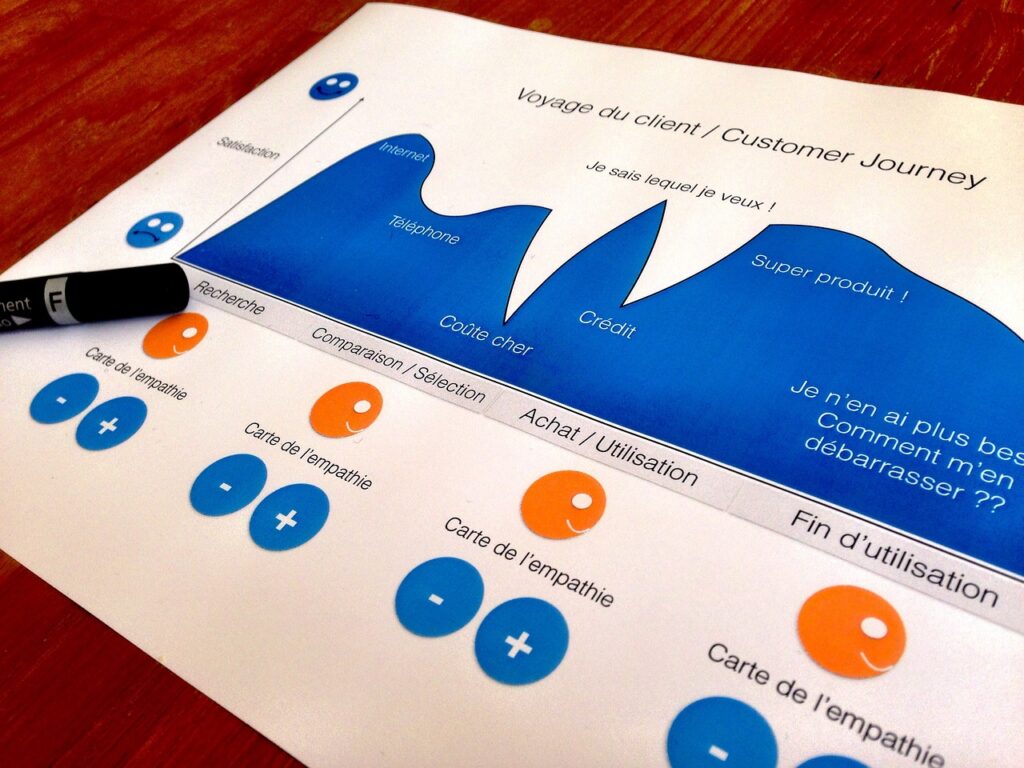On the eve of 2024, the world of marketing is facing unprecedented change. With consumers becoming increasingly informed and demanding, as well as more competitive, the importance of identifying and influencing the consumer purchasing path becomes paramount.
In this article, we dive deep into the most effective marketing channels for 2024, offering expert analysis to help you navigate these changes and position your brand for success. Learn how to choose your marketing channels wisely to maximize visibility and impact with your target audience, as we explore the techniques and strategies that will define tomorrow's marketing landscape.
Emerging Marketing Channels
In an era where technology shapes every aspect of our lives, emerging marketing channels represent an exciting frontier for brands keen to innovate and stand out from the crowd. These channels, while less traditional, offer unprecedented opportunities to engage consumers in interactive dialogue, creating a richer, more personalized customer experience. It is essential for companies to understand and exploit these new media to remain competitive in the ever-changing digital landscape of 2024.
Optimization for Voice Search
Optimizing for voice search is becoming increasingly crucial as more consumers adopt voice-assistant technologies, such as Google Assistant, Apple's Siri, and Amazon's Alexa, to search for information, products and services. For brands, this means that content and SEO strategies must be adapted to understand and respond to orally formulated queries, which are often longer and more conversational than traditional text searches. This implies not only a deep understanding of users' intentions, but also optimization of local information, since many voice searches are carried out with the aim of finding nearby establishments and services.
Augmented Reality Marketing
Augmented reality (AR) marketing is emerging as a powerful tool, transforming the customer experience and offering a new dimension to brand-consumer engagement. This technology enables virtual elements to be integrated into the real world, creating an immersive, interactive experience. AR's applications in marketing are vast, from virtual product trials to enriched brand experiences, offering companies a captivating way to showcase their products and services.
Immersive E-commerce
With the advent of AR, e-commerce is set to become a more immersive and interactive experience. Online stores can now enable consumers to virtually try on products, such as clothing, eyewear, and even make-up shades, from the comfort of their own homes. This approach not only increases user engagement but can also significantly reduce return rates, by giving customers a better appreciation of products before purchase.
Interactive Advertising
AR ads offer a unique opportunity for brands to stand out in a crowded advertising space. By integrating interactive elements that encourage users to participate rather than simply observe, companies can create more engaging and memorable advertising campaigns. This is particularly effective for reaching younger audiences, who value enriching, interactive experiences.
Events and Virtual Product Launches
Events and product launches using AR can reach a global audience, transcending geographical and physical boundaries. By creating virtual experiences, brands can engage participants from all over the world, increasing their reach and impact. These virtual events offer a flexible, cost-effective alternative to physical gatherings, while providing a platform for dynamic, interactive product presentations.
By exploring and embracing augmented reality marketing, brands can not only enhance the customer experience, but also position themselves at the forefront of technological innovation. The ability to create more personal and immersive shopping experiences represents a significant competitive advantage in the digital landscape of 2024.
Video Marketing Trends
Video marketing continues to dominate content strategies in 2024, evolving with new technologies to capture consumer attention more effectively and memorably. Here are some of the key trends we're seeing:
Live Streaming
Live streaming is gaining ground, offering brands a platform to connect with their audience in real time. This authentic approach can humanize a brand, build an engaged community around live events, and stimulate interaction and immediate feedback from consumers.
360-Degree Video
360-degree video, enhanced by advances in AR and VR, allows users to immerse themselves completely in the environment being presented. For brands, this represents an unrivalled opportunity to present their products or services in an entirely new and captivating way, offering consumers a truly immersive experience.
User-Generated Content
User-generated video content (UGC) continues to prove its importance, establishing an authenticity that audiences are increasingly seeking in brand communication. Encouraging consumers to share their own content can not only increase engagement, but also provide companies with credible and persuasive promotional material.
Video Storytelling
Storytelling remains a mainstay of video marketing, with an increased emphasis on compelling narratives that resonate emotionally with the audience. Brands that succeed in weaving stories around their products or services, focusing on experiences rather than features, can create deep connections with their audiences.
By integrating these trends into their video marketing strategy, brands can not only stay relevant, but also create more engaging and memorable campaigns that truly resonate with their target audience.
Influence Marketing Strategies
Influencer marketing continues to transform, becoming a central element of digital communication strategies in 2024. Thanks to their ability to forge authentic connections with audiences, influencers play a crucial role in promoting brands and products. Here are some key strategies companies are adopting to maximize the effectiveness of their influencer marketing campaigns.
Careful selection of influencers
The selection of influencers is more strategic than ever, favoring quality over quantity. Brands seek partnerships with influencers whose values and audience correspond precisely to their target. Authentic alignment between brand and influencer is essential to guarantee the impact and credibility of the messages conveyed.
Long-term partnerships
Brands tend to establish long-term partnerships with influencers, rather than limiting themselves to one-off collaborations. This builds consistency and loyalty in communication, making the influencer's endorsement more credible and influential with his or her audience.
Exploiting Niches of Influence
Faced with market saturation, brands are turning to niche influencers with smaller but highly engaged audiences. These collaborations enable specific market segments to be reached in a more direct and personalized way, optimizing campaign effectiveness.
In-depth Performance Measurement
The evaluation of influencer marketing campaigns is becoming increasingly refined, with a focus on clear, quantifiable performance indicators. Beyond reach and number of impressions, brands are focusing on return on investment (ROI), real engagement, and the fit of content with strategic objectives.
By adopting a more targeted, personalized and strategic approach, brands can harness the full potential of influencer marketing campaigns. These strategies not only improve the visibility of products and services, but also create an authentic and lasting connection with the target audience, reinforcing brand trust and loyalty.
Advanced strategies for established channels
In the relentless quest to stand out in a saturated digital environment, understanding and mastering established marketing channels is becoming crucial. This section explores advanced and proven strategies that enable brands to strengthen their presence on these platforms. We dive into the mechanisms of content diversification, SEO optimization, and audience engagement and loyalty. These approaches are designed to maximize impact across channels such as social networks, blogs, and email marketing, ensuring that brands don't just exist, but thrive in the digital space of 2024.
SEO Best Practices
Search Engine Optimization (SEO) remains a cornerstone of any brand's online visibility. To adapt to the constant changes in search engine algorithms, here are a few essential practices:
Optimization for Voice Search
With the increasing use of voice assistants, optimizing content for voice search is becoming a must. This means incorporating natural language queries and frequently asked questions into web content.
The importance of User Experience (UX)
The user experience on websites, including loading speed, ease of navigation and mobile accessibility, plays a key role in SEO rankings. Brands need to ensure that their website offers an optimal user experience.
High-quality, relevant content
Content remains king. Publishing original, relevant, high-quality content that meets users' information needs is essential for improving SEO rankings. The aim is to engage visitors, reduce bounce rates and encourage shares and backlinks.
E.A.T strategy (Expertise, Authoritativeness, Trustworthiness)
Google values websites that demonstrate expertise, authority and reliability in their field. It is therefore crucial for brands to establish their credibility by providing proof of their know-how and the authenticity of their information.
Adapting to these SEO practices not only benefits search engine rankings, but also improves the overall user experience, which is fundamental to converting traffic into qualified leads and loyal customers.
Innovations in Social Network Advertising
Advertising on social networks is constantly reinventing itself, and in 2024, innovation in this field is at its peak. To stay competitive, brands need to adopt innovative approaches that capture their audience's attention in a saturated digital environment. Here are a few key trends:
Accelerated use of Augmented Reality (AR)
Augmented reality offers immense potential for advertising campaigns on social networks, enabling immersive and memorable interaction with products. Innovative brands are using AR to create virtual trial experiences, enhancing engagement and personalizing the customer experience.
Short and Perceptive Video Commercials
With the emergence of platforms like TikTok and Instagram stories, short formats are dominating the video advertising scene. The creation of succinct, captivating video content, tailored to the ephemeral consumption habits of the target audience, is becoming paramount.
Social Commerce integration
Social commerce transforms social networks into true shopping platforms, enabling users to buy directly from advertisements. This integration delivers a seamless user experience and boosts conversion rates for brands.
Advanced personalization thanks to AI
Artificial intelligence plays a key role in ad personalization, analyzing user data to deliver highly targeted content. AI enables brands to create advertising campaigns that resonate meaningfully with each segment of their audience.
By embracing these innovations, brands can not only boost the visibility of their products and services on social networks, but also engage their audience in a more meaningful and emotional way, boosting loyalty and conversion.
Email Marketing Automation
Email marketing automation is a key strategy for brands wishing to communicate effectively and systematically with their audience. This technique makes it possible to personalize the customer journey by proposing relevant messages based on users' actions and behaviors.
Personalization and Segmentation
The use of automation enables audiences to be segmented according to specific criteria such as site behavior, purchase history or expressed preferences. This advanced segmentation helps to send highly personalized emails that meet the needs and interests of each segment.
Timely delivery
Automation offers the possibility of scheduling emails to be sent at times deemed optimal, thus improving open and interaction rates. Whether for abandoned shopping baskets, anniversaries or renewal reminders, precise timing can significantly increase the effectiveness of email campaigns.
Performance monitoring and analysis
Automation platforms provide analysis tools that enable real-time monitoring of email campaign performance. Brands can adjust their strategies based on data collected, such as open, click and conversion rates, to constantly optimize their ROI.
Dynamic Content Integration
Incorporating dynamic content into emails, such as videos, polls or interactive sliders, engages recipients even more. This innovative approach captures attention and encourages deeper interaction with email content.
The adoption of email marketing automation enables brands to improve operational efficiency while delivering a personalized and engaging customer experience. By leveraging these technologies and strategies, companies can significantly increase their reach and market impact.
Data-Driven Marketing Approaches
The era of intuitive marketing is giving way to more analytical, data-driven marketing. This evolution represents an essential strategy for brands wishing to optimize their marketing actions and better understand their target audiences. Thanks to the judicious use of data, companies can refine their marketing strategies to achieve results that are both more precise and more effective.
Advanced Analytics for Deep Understanding
Extensive use of analytics enables marketers to gain a deep understanding of consumer behavior. By examining data trends, brands can anticipate the wants and needs of their targets, enabling them to create more relevant and personalized campaigns.
Precise Audience Segmentation
Advanced audience segmentation is another concrete application of data-driven marketing. By grouping consumers into precise segments according to their behavior, preferences and interactions with the brand, companies can design specific marketing messages, boosting engagement and conversion.
Real-time optimization
Real-time analysis of campaign data enables brands to quickly adjust their strategies to maximize impact. This operational flexibility ensures that marketing actions always remain aligned with current trends and consumer feedback, guaranteeing higher success rates.
Data-Driven Decision Making
Finally, data-driven marketing promotes more informed, less risky decision-making. Brands rely on concrete insights rather than hunches, enabling more efficient allocation of resources and better anticipation of risks and opportunities.
The adoption of data-driven marketing strategies is essential in an increasingly competitive business environment. By intelligently harnessing the data at their disposal, brands can not only improve the relevance and effectiveness of their campaigns, but also strengthen relationships with their audience, leading to significant, sustainable growth.
Targeting Specific Audiences
Targeting specific audiences represents a central pivot in modern marketing strategy, enabling brands to communicate more effectively and personally with their target audience. This sophisticated approach to marketing aims to identify and reach distinct groups of consumers, whose interests, behaviors and needs are aligned with the product or service offering. At the heart of this process lies a brand's ability to segment its audience precisely, thus echoing the specific expectations of each group and optimizing the return on investment of advertising campaigns.
Customization Techniques
Personalization has become a cornerstone of modern marketing strategies. Thanks to advances in technology and analytics, brands now have the ability to create unique experiences for each individual, boosting engagement and building customer loyalty.
Custom Content Creation
Personalized content is designed to resonate specifically with each user's interests, needs and preferences. By leveraging demographic, behavioral and transactional data, companies can develop tailored messages that significantly increase the effectiveness of brand-customer interactions.
Intelligent Product Recommendations
Product recommendations based on past behavior and user preferences are a powerful example of personalization. These systems use complex algorithms to suggest relevant products or services, enhancing the shopping experience and increasing conversion rates.
Targeted Campaigns by Life Event
Identifying and acting on important events in consumers' lives, such as birthdays, anniversaries or the arrival of a child, makes it possible to create highly personalized and emotionally engaging communications. These campaigns show customers that the brand values and understands the milestones in their personal lives.
Personalized User Experiences on Digital Platforms
Tailoring user experiences on websites and mobile applications to individual preferences is another dimension of personalization. By adjusting content, offers and user interface to reflect past interactions, brands can create a fluid and intuitive customer journey.
By integrating these personalization techniques into their overall strategies, brands can achieve unprecedented levels of customer engagement and loyalty. The key lies in the judicious deployment of technology and deep data analysis to understand and anticipate each customer's unique needs.
Account-Based Marketing
Account-Based Marketing (ABM) represents a focused strategy, in which marketing and sales efforts are aligned with a specific set of target accounts. This approach enables extreme personalization and greater efficiency in reaching the most valuable customers. ABM is particularly effective for B2B companies, where sales cycles are long and purchasing decisions often involve several stakeholders within the target organization.
Defining Target Accounts
The first step in Account-Based Marketing is the precise identification of the most strategic accounts for the company. This selection is based on an in-depth analysis of historical data, revenue potential, and the match between the potential customer's needs and the company's proposed solutions.
Custom Content Strategies
Once target accounts have been defined, the creation of highly targeted, personalized content is essential. This content must resonate with the specific challenges and opportunities identified within each account, offering distinct added value and facilitating the customer's buying journey.
Integrated multichannel campaigns
Successful ABM relies on the execution of coordinated campaigns across various channels - email, social networks, events, direct advertising - to consistently engage key stakeholders within target accounts. The aim is to create a personalized omnichannel experience that supports the shared goal of conversion and loyalty.
Performance Measurement and Optimization
Ongoing evaluation of the effectiveness of ABM efforts is crucial. By using specific key performance indicators (KPIs), such as ROI, conversion rate, and target account engagement, marketing and sales teams can fine-tune their strategies to maximize impact and ROI.
In short, Account-Based Marketing is a powerful strategy that requires close collaboration between marketing and sales teams. By focusing on highly targeted accounts and tailoring the marketing approach to meet the specific needs of each account, companies can achieve significant growth and strengthen long-term relationships with key customers.
Cross-channel integration
Cross-channel integration is a must in today's marketing landscape, enabling seamless consistency in customer communications across all touchpoints. A well-executed strategy delivers a seamless user experience, strengthening engagement and amplifying brand loyalty.
Brand consistency across all channels
Brand consistency is essential to maintain trust and recognition in the hearts of consumers. This means that the message, tone, design and customer experience must be consistent, whether the consumer interacts with the brand on social networks, the website, by email or in-store.
Communications Orchestration
Efficiently orchestrating communications across different channels helps to guide consumers through the buying journey in a fluid, natural way. By using data and analytics to understand consumer preferences and behaviors, brands can deliver the right message, at the right time, via the most appropriate channel.
Technology and Integrated Platforms
Implementing cross-channel integration requires technologies capable of synchronizing data and interactions across all channels. This means adopting customer relationship management (CRM) platforms, content management systems (CMS) and other marketing automation tools, guaranteeing a unified view of every customer.
Cross-Channel Performance Measurement
To continually improve the customer experience and optimize marketing strategies, accurate measurement of performance across all channels is crucial. Indicators such as engagement rate, conversion and return on investment (ROI) need to be collected and analyzed to identify areas of excellence and opportunities for improvement.
By embracing a cross-channel integration strategy, brands can not only increase their marketing effectiveness, but also create deeper, more meaningful connections with their customers. It's a holistic approach that recognizes and harnesses the complexity of today's customer journeys, paving the way for sustainable loyalty and sustained growth.
Measuring success and ROI
In the competitive world of marketing, measuring success and return on investment (ROI) is crucial to assessing the effectiveness of implemented strategies and adjusting future actions. This section will focus on methods and techniques for quantifying the results of marketing campaigns, with particular emphasis on the importance of data and analysis in strategic decision-making. We'll explore how a rigorous approach to measurement can not only justify marketing investments, but also illuminate the path to ongoing campaign optimization for maximum impact.
Analytical Tools and Metrics
To evaluate the effectiveness of marketing campaigns and the overall performance of corporate strategies, the adoption of advanced analytical tools and the monitoring of appropriate metrics are essential. These tools make it possible to accurately measure the success of initiatives and optimize marketing investments for maximum return on investment (ROI).
Choice of Analytical Tools
The choice of analytics tools must be aligned with the company's specific objectives and the nature of its campaigns. Platforms such as Google Analytics, Adobe Analytics and specialized ABM tools can provide deep insights into user behavior, channel effectiveness and content performance.
Key Metrics to Follow
Identifying and tracking the right metrics is crucial to a thorough understanding of performance. Among the most significant metrics are conversion rate, cost per acquisition (CPA), return on advertising spend (ROAS), engagement on social networks and account health score for ABM strategies. These metrics offer a clear view of the value generated by different marketing actions.
Data analysis and interpretation
The analysis of data gathered through analytical tools must lead to concrete action. This involves interpreting metrics in the context of business objectives, identifying trends, successes and areas for improvement. In-depth analysis enables us to better understand the customer journey and adjust strategies for optimum performance.
Reports and Data Visualization
Detailed reporting and data visualization help communicate analysis results to stakeholders. Using intuitive dashboards and graphical representations helps to simplify the complexity of data and facilitate strategic decision-making at all levels of the company.
By effectively integrating analytical tools and focusing on relevant metrics, companies can not only accurately measure the success of their actions, but also uncover optimization opportunities for future marketing campaigns. This analytical approach transforms data into actionable insights, leading to continuous improvement and increased ROI.
Conversion Rate Optimization
Conversion rate optimization (CRO) is a crucial component in maximizing the profitability of marketing investments. It involves improving the effectiveness of web pages and campaigns to convert more visitors into customers.
Optimization strategies
Adopting a structured approach to conversion rate optimization involves analyzing user paths, implementing systematic A/B testing, and using customer feedback to fine-tune messages and site ergonomics. It's all about understanding the obstacles to conversion and eliminating them.
The importance of User Experience (UX)
An optimal user experience is essential to encourage visitors to perform the desired action. This means intuitive design, easy navigation, clear calls to action, and fast loading times. The UX must be carefully designed to guide the user towards conversion without friction.
Content customization
Personalized content plays a significant role in increasing conversion rates. By tailoring messages, offers and recommendations to users' preferences and behavior, brands can significantly improve engagement and incite action.
Continuous Monitoring and Improvement
Conversion rate optimization is an ongoing process. It requires regular monitoring of performance, analysis of A/B test results, and adjustment of strategies according to the data collected. Only an iterative approach makes it possible to adapt to changes in consumer behavior and constantly optimize campaign effectiveness.
By implementing these optimization practices, companies can significantly improve the conversion of visits into concrete actions, be they purchases, registrations or downloads. This requires a detailed understanding of users' needs and expectations, as well as the ability to translate these insights into effective strategic and tactical actions.
A/B Testing for Campaign Optimization
A/B testing is an essential method for improving the effectiveness of marketing campaigns, by comparing two versions of the same page or campaign to determine which performs better.
Definition and significance
A/B testing involves presenting two variants (A and B) of a marketing element to similar segments of the audience to observe which generates the better conversion rate or achieves the set objective. This approach is fundamental because it's based on real data rather than guesswork, leading to informed, optimized decisions.
Implementation of A/B Tests
To carry out A/B tests successfully, it's essential to clearly define the objective, choose the element to be tested (e.g., a call-to-action button, headlines, images), divide the audience randomly and fairly, and use specialized tools to analyze the results. Clarity of purpose and rigor of execution are key to obtaining valid conclusions.
Results analysis
Once the A/B test is complete, the results must be analyzed in depth, examining not only the element tested, but also the impact on broader metrics such as overall conversion rate, engagement and user behavior. This analysis should inform future strategic and tactical decisions.
Adaptation and Iteration
The insights gleaned from A/B testing should be used to continually refine the campaigns and elements tested. Even a small change can have a significant impact on performance. Iteration, based on a data-driven approach, is essential for continuous optimization.
A/B testing, with its ability to offer insight based on real performance data, is a powerful lever for increasing the effectiveness of marketing campaigns. By integrating these tests into regular practices, companies can continually improve user experience and conversion rates, leading to sustained, profitable growth.
Towards a Successful Future: Mastering the Consumer Purchasing Journey in 2024
It's crucial for marketers to remain vigilant and embrace the ongoing evolution of digital marketing. The insights provided are intended to light your way towards a relevant and adaptive marketing strategy. Fluidity and adaptability are more necessary than ever in this rapidly changing digital world.
By staying informed, learning and innovating, your brand can only thrive. Position yourself at the forefront of tomorrow's marketing channels and effectively influence the consumer purchasing path to guarantee long-term success.











